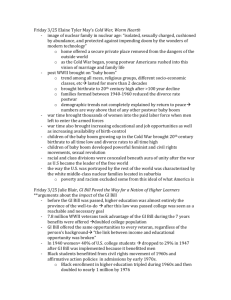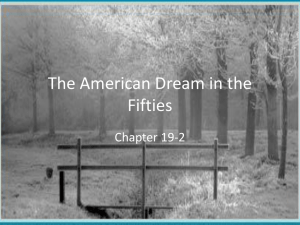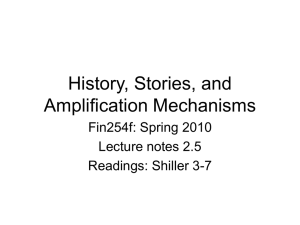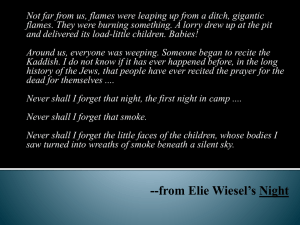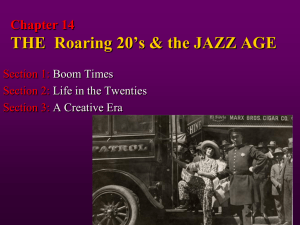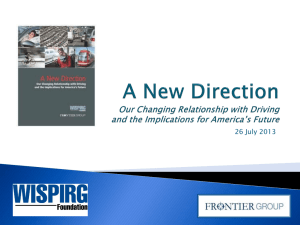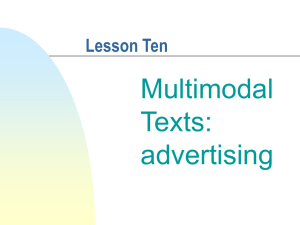Chapter 19 Section 1 - Guthrie Public Schools
advertisement
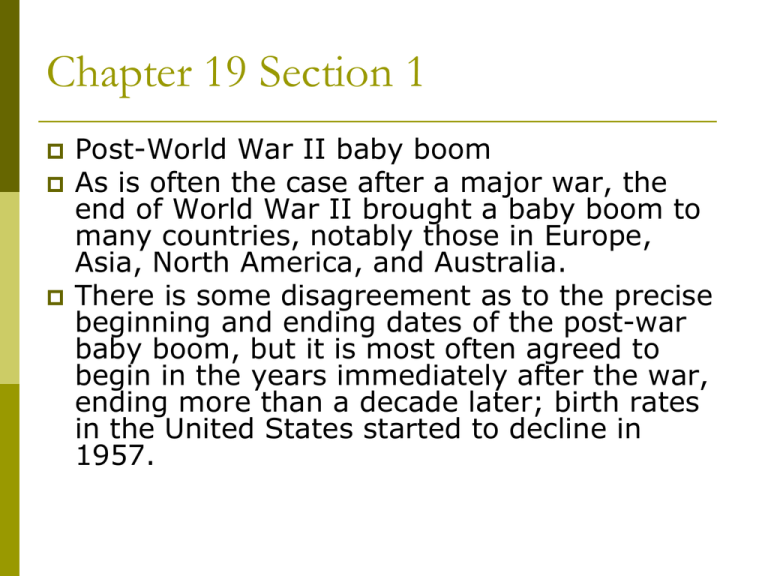
Chapter 19 Section 1 Post-World War II baby boom As is often the case after a major war, the end of World War II brought a baby boom to many countries, notably those in Europe, Asia, North America, and Australia. There is some disagreement as to the precise beginning and ending dates of the post-war baby boom, but it is most often agreed to begin in the years immediately after the war, ending more than a decade later; birth rates in the United States started to decline in 1957. Chapter 19 Section 1 In May 1951, Sylvia Porter, a columnist for the New York Post, used the term "boom" to refer to the phenomenon of increased births in post war America. She wrote: There are an estimated 78.2 million Americans who were born during this demographic boom in births. Many experts now believe that two distinct generations were born during this baby boom; the older generation is usually called the Baby Boom Generation and the younger generation is usually called Generation Jones. Baby Boomers are now middle age and entering senior years. In the economy, many are now retiring and leaving the labor force. Chapter 19 Section 1 Causes Before the Baby Boom, there was a period of approximately 20 years in which having children was difficult because of the effects of the Great Depression and World War II. The Baby Boom reflected the sudden removal of economic and social restraints that kept people from starting families. While austerity and restraint were the norms during the stress of the war years, after the war, couples reunited and returned to traditional roles. Returning (mostly male) soldiers re-entered the workforce; many women left wartime work to concentrate on childbearing and child-rearing. Marriage became again a cultural and career norm for most women, and the result was an increase in the birth rate. Chapter 19 Section 1 The boom continued in the economic glow of the fifties, but dampened its rate as the recession of 1958 sloughed into the following recovery. One theory about the end of the baby boom is that it fizzled out as the biological capacity of boomer parents took its course. The advent of the birth control pill in 1960 in the U.S. also contributed to the slowing birth rate, as previous contraceptive methods were less popular or reliable. Chapter 19 Section 1 In the United States alone, approximately 78 million babies were born between those years. By the end of the 1940s, about 32 million babies had been born, compared with 24 million in the 1930s. In 1954, annual births first topped four million and did not drop below that figure until 1965, when four out of ten Americans were under the age of twenty. Chapter 19 Section 1 During the war unemployment ended and the economy greatly expanded; afterwards the country experienced vigorous economic growth until the 1970s. The G.I. Bill enabled record numbers of people to finish high school and attend college. This led to an increase in stock of skills and yielded higher incomes to families. Chapter 19 Section 1 The exact beginning and end of the baby boom can be debated. In the United States, demographers usually use 1946 to 1964, although the U.S. birthrate began to shoot up in 1941 and to decline after 1957. By 1948 the US population increase was back to the pre-Depression increase rate of about 1.5% per year. The five percent "baby boom" increase of 1946 and the trickle into 1947 barely impacted the US population growth rate between 1900 and 2004. Chapter 19 Section 1 Marriage rates rose sharply in the 1940s and reached all time highs. After WWII Americans began to marry at a younger age,. The average age of a person at their first marriage dropped to 22.5 years for males and 20.1 for females, down from 24.3 for males and 21.5 for females in 1940. Getting married immediately after high school was becoming commonplace and women were increasingly under tremendous pressure to marry by the age of 20. A common stereotype stated that women were going to college to earn their M.R.S. (Mrs.) degree. Chapter 19 Section 1 Family size-Family size increased sharply throughout the baby boom. The average woman bore 3.09 children in 1950 which increased to 3.65 children per family in 1960, but the peak was in 1957, when the figure stood at 3.77. Most couples became pregnant with their first child within 7 months of their wedding; between 1940 to 1960, the number of families with three children doubled and the number of families having a fourth child quadrupled. Chapter 19 Section 1 Quiz • • • • • 1.) Name one thing that happened after World War II? a.) Russia became an ally b.) Americas went into the Great Depression c.) The Baby Boom • • • • 2.) When did World War II end? a.) 1965 b.) 1914 c.) 1945 • • • • • 3.) How old are baby boomers today? a.) In their 60’s b.) In their 40’s c.) In their 80’s • 4.) What happened to the U.S. economy after the war? a.) The Economy Grew until the 70’s b.) The Economy Stalled until the 70’s c.) The Economy fell into a depression until the 70’s • • • • • • • 5.) Approximately how many babies were born during the Baby boom? a.) 76,000 b.) 76 Million c.) 176 Million • • • • • • • • • • • • • • • • • • 6.) When is the most accepted beginning date for the Baby Boom? a.) 1946 b.) 1966 c.) 1956 7.) At what age did Americans start marrying after WWII? a.) At the same ages as before b.) At a later age c.) At a younger age 8.) At what period in young peoples live did it become common to get married? a.) After graduating High School b.) Before graduating High School c.) The age of people getting married stayed the same 9.) What happened to family size during the Baby Boom? a.) It stayed the same b.) Families became smaller c.) Families become larger 10.) What was a common stereotype of women? a.) Women were going to college to get their M.R.S. degree b.) Women were going to college to be prepared for the work force after graduation c.) Women had shown that they were great front line warriors

